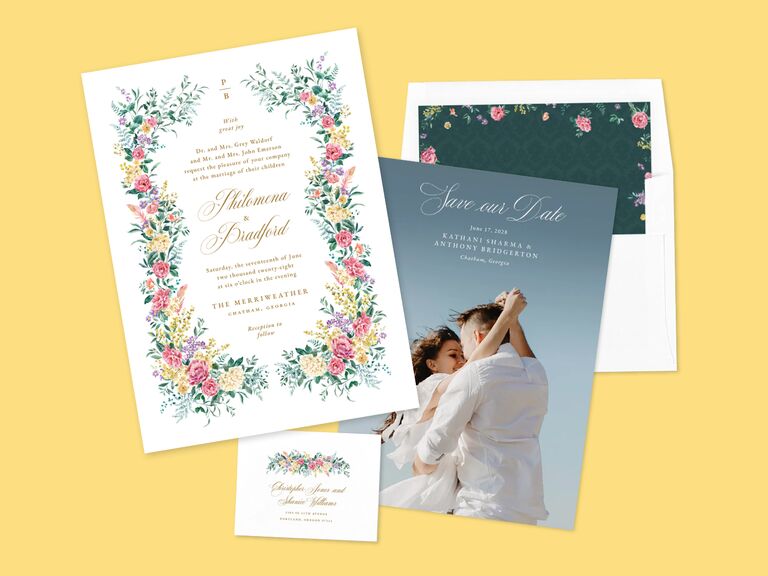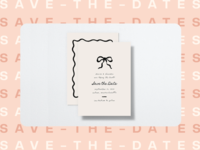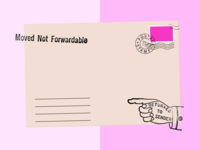Your Go-to Guide for Save-the-Dates vs. Invitations

Once you've nailed down the date, venue and guest list, you need to let your guests know as soon as possible so they can plan ahead. When it comes to save-the-dates versus invitations, both help do this in their own way, and matching versions of both can be found at The Knot Paper. Save-the-dates give the most basic information: the date and the location. They may even include a link to your wedding website on The Knot with more information. Invitations are sent to guests a little closer to the actual wedding and usually require a reply to get an official head count for your vendors. Need a little guidance on what the similarities and differences are between a save-the-date versus a wedding invitation? We can help.
In this article:
- Are Save-the-Dates and Wedding Invitations the Same?
- The Differences Between Save-the-Dates and Invitations
- The Similarities Between Save-the-Dates and Invitations
Are Save-the-Dates and Wedding Invitations the Same?
Save-the-dates and invitations are both important ways to keep your guest list informed about your wedding day plans, but they are not the same. While they both serve the same basic function—informing guests—there are some differences that are important to keep in mind when it comes to messaging, vibe, style and timing.
The Differences Between Save-the-Dates and Invitations
There are multiple differences when it comes to save-the-date etiquette. Read on to learn about what to include on save-the-dates and wedding invitations and how they differ from one another.

1. Purpose
This is the biggest key difference between wedding invitations and save-the-dates; it's even in the name! "Save-the-dates are exactly what they sound like—a heads-up to your guests so they can mark their calendars," explains Julian Leaver of Julian Leaver Events based in Dallas. "Save-the-date cards are best used to alert wedding guests that the wedding is coming up and should include accommodation information for out-of-town guests to book ahead of time," says Cink DeVeas of Cink Art based in Severna Park, Maryland. "They are especially effective for destination weddings where most guests will require transportation and overnight stay arrangements."
2. Timing
Save-the-dates are basically a calendar hold for your wedding. It's a good way to let your guests know that they shouldn't make any plans for that day, and the further in advance you send them, the better chance you'll have of everyone you invite being able to attend. So, when should you send wedding invitations versus save-the-dates? "Save-the-dates typically go out 6–12 months before the wedding, depending on whether you're planning a destination wedding or expecting lots of out-of-town guests," Leaver recommends. "Invitations are sent closer to the date, usually around 8–12 weeks out."
3. Details Included
For save-the-date wording, you'll want to include the date, location and wedding website. Wedding invitation wording gets much more specific with the time of the wedding, the exact location of the ceremony and reception and includes other important day-of details. "Save-the-dates are intentionally simple: your names, the wedding date, and the city or venue (and maybe a wedding website)," Leaver says. "Invitations are more detailed—they include ceremony time and location, reception details, dress code, RSVP information, and often multiple enclosures depending on the complexity of your event."
4. No Response Needed
Save-the-dates are more of an FYI, whereas invitations require a yes or no reply regarding your attendance, the name of your guest (if you get a plus-one), and what you'd like to eat (if they're offering a plated dinner). Typically, a card is enclosed where you can provide that information, or a website link or wedding QR code is provided for you to RSVP.
5. Etiquette and Tone
"Save-the-dates can be more casual, playful or even modern in design—they're your chance to give a little personality preview," Leaver explains. "Invitations are more formal and follow more traditional wedding invitation etiquette rules in both wording and presentation, setting the tone for your celebration." Trying to save money? "Consider e-vite types of save-the-dates so you have more to spend on a nice custom invitation," DeVeas recommends.
The Similarities Between Save-the-Dates and Invitations
There are a few things that wedding invitations and save-the-dates have in common. Read on to learn how the two are similar.
1. They're Both Essential
You shouldn't include one without the other. While they serve different functions, they're both a big part of how to communicate important information. "Both pieces of stationery should contain the who, what, where and when of the wedding; the invitations share many more details of the event," DeVeas says.
2. They Both Go to the Same Guest List
This is not an opportunity to get a sense of who will or won't come. Some people might take the opportunity to book flights early as a way to save money. "Anyone who receives a save-the-date must receive an invitation," Leaver explains. "It's a promise of inclusion, not a maybe. Once you send it, that guest is officially on the list."
3. Both Require Accuracy
Think about your save-the-dates and invitations like a paper you're going to turn in. Make sure you double-check for spelling errors before sending. "Names should be spelled correctly, locations should be confirmed, and dates should be absolutely final before anything is printed or mailed," Leaver recommends. Avoiding errors will also help you save on unnecessary wedding stationery costs.
4. Work With Your Planner and Stationer on Both
You want to make sure your planner and stationer, or invitation vendor, are included from beginning to end. Plus, they can help you differentiate the information that goes on the save-the-dates versus invitations and let you know what should be on your wedding invitation suite checklist. "There are a lot of moving parts—RSVP cards, inserts, postage and timelines," Leaver says. "We'll help make sure nothing is missed and everything feels cohesive and intentional."
5. They Should Reflect the Wedding Vibe
"Save-the-dates can be designed to match the invitation, and if custom artwork is used on them, the same art can be incorporated into the wedding invitation in some fashion," DeVeas explains. Achieve this by coordinating your save-the-dates with your wedding website and matching invitations.



























